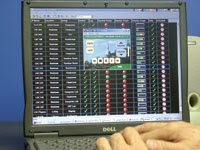
To date, teleconferencing between colleagues and offices is a convenient way of communicating despite being separated by thousands of miles. Unfortunately, the level of quality isn’t exactly up to par as you won’t get what you see on high definition TV today, let alone standard definition. Telepresence technology aims to change all that, offering an alternative to traditional video teleconferencing. Imagine expanding your traditional fabric business to international clientèle by using Telepresence technology to beam images of the current fabric you’re designing, much to your client’s pleasure at seeing a masterpiece being unveiled as if he/she is located in the very same room.
To get a better idea on just how clear the images are, imagine viewing a face that was ruddy, spotting moles on a lady’s arms, while seeing sweat patches in the underarm area of your superior appearing on high definition TV. The size of these images are just stupendous – what you get over Telepresence is near life-size proportions in vivid color, letting people in either room to make eye contact with one another while holding a decent conversation with over 6,000 miles standing in between them. Sounds like executives who are frequent globe trotters no longer need to rack up their frequent flier miles with Telepresence technology since they can spend time in the “presence” of their families (and vice versa).
This new technology has not yet proliferated across offices just yet, with just a small percentage of the video teleconferencing market using Telepresence. One of the main reasons would be its prohibitive cost – setup at a few sites as well as a year’s worth of expenses could rack up a bill worth a whopping $500,000. Not only that, you still have niggling problems such as different standards being established, running the risk of incompatibility between systems. Ghosting problems are still prevalent, while slow bandwidth will result in slow loading times.
To get a better idea on just how clear the images are, imagine viewing a face that was ruddy, spotting moles on a lady’s arms, while seeing sweat patches in the underarm area of your superior appearing on high definition TV. The size of these images are just stupendous – what you get over Telepresence is near life-size proportions in vivid color, letting people in either room to make eye contact with one another while holding a decent conversation with over 6,000 miles standing in between them. Sounds like executives who are frequent globe trotters no longer need to rack up their frequent flier miles with Telepresence technology since they can spend time in the “presence” of their families (and vice versa).
This new technology has not yet proliferated across offices just yet, with just a small percentage of the video teleconferencing market using Telepresence. One of the main reasons would be its prohibitive cost – setup at a few sites as well as a year’s worth of expenses could rack up a bill worth a whopping $500,000. Not only that, you still have niggling problems such as different standards being established, running the risk of incompatibility between systems. Ghosting problems are still prevalent, while slow bandwidth will result in slow loading times.
























